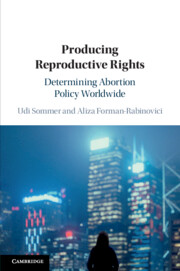Book contents
- Producing Reproductive Rights
- Producing Reproductive Rights
- Copyright page
- Dedication
- Contents
- Figures
- Tables
- Preface
- Acknowledgments
- 1 Introduction: Producing Reproductive Rights
- Part I Civil Society Sphere
- 2 The Civil Society Sphere: Religion and Reproductive Health
- 3 The Politics of Religion and Reproductive Health: The Cases of Chile and Bahrain
- Part II State Government Sphere
- Part III The International Sphere
- 8 Conclusions
- References
- Index
2 - The Civil Society Sphere: Religion and Reproductive Health
from Part I - Civil Society Sphere
Published online by Cambridge University Press: 27 July 2019
- Producing Reproductive Rights
- Producing Reproductive Rights
- Copyright page
- Dedication
- Contents
- Figures
- Tables
- Preface
- Acknowledgments
- 1 Introduction: Producing Reproductive Rights
- Part I Civil Society Sphere
- 2 The Civil Society Sphere: Religion and Reproductive Health
- 3 The Politics of Religion and Reproductive Health: The Cases of Chile and Bahrain
- Part II State Government Sphere
- Part III The International Sphere
- 8 Conclusions
- References
- Index
Summary
We start with the civil society sphere. Within civil society, we engage with religion as a defining feature that has long been assumed to have a fractious relationship with women’s rights and gender equality. The effects of religion in the area of gender equality have been considered substantial in academic work as well as in popular and political discourse. A common understanding is that religion depresses women’s rights in general and reproductive and abortion rights in particular. The literature on reproductive rights, however, is disproportionately focused on Western cases, and is limited in its definition of religion as a variable. What happens, though, when we switch to a more inclusive framework? To what extent do a variety of religious variables correlate with policy on reproductive rights outside of the Western context? We examine the relevance of the religion-abortion link in a broad comparative framework looking at religious sect, religiosity, religious diversity, and the relationship between religion and the state. The comparative analyses suggest that the connection between religion and women’s reproductive rights is far more nuanced than previously thought.
Keywords
- Type
- Chapter
- Information
- Producing Reproductive RightsDetermining Abortion Policy Worldwide, pp. 19 - 55Publisher: Cambridge University PressPrint publication year: 2019

